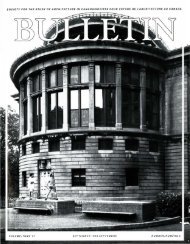CANADA - SEXTONdigital
CANADA - SEXTONdigital
CANADA - SEXTONdigital
Create successful ePaper yourself
Turn your PDF publications into a flip-book with our unique Google optimized e-Paper software.
J ULIAN S M ITH > ESSAY I ESSAI<br />
FIG . 11. VILLA SAVOYE, LE CORBUSIER, RESTORED. I PIE.IUI£ ou PREY 1987.<br />
which arranged the plates in careful sequence<br />
starting with the perfect whole<br />
and then exploring the parts. The impact<br />
of Stuart and Revett's work was significant.<br />
It helped create an appreciation for<br />
Greek architecture, and more broadly for<br />
Greek civilization, as epitomizing purity<br />
of form and conception. It created<br />
a Greek architecture of the imagination<br />
that has become, over time, as significant<br />
in later interpretations of the classical as<br />
the monuments themselves.<br />
Like the Parthenon, Vi my exists as a formal<br />
abstraction and as an evocative element<br />
within the surrounding battlefield landscape.<br />
The retention of a pockmarked terrain<br />
of suffering and terror, as a setting<br />
for the monument, strongly differentiates<br />
Vi my from its other World War I counterparts.<br />
The juxtaposition works when we<br />
see the whiteness and perfection of the<br />
monument against this dark and messy<br />
landscape. Were the monument to decay,<br />
would the power of this juxtaposition be<br />
reduced? If we had to rely only on photographic<br />
images of the site, the answer to<br />
this question would have to be yes . The<br />
stark contrast would fade over time. On<br />
the other hand, if the perfection of the<br />
monument lived on in our imagination,<br />
reinforced by appropriate representation,<br />
it is possible that we could accept decay<br />
and still sense the power of the site as<br />
Allward envisioned it.<br />
Retention of value through modes of representation<br />
is a complex subject, and not<br />
well developed as part of the discussion<br />
of conservation options. It is not surprising<br />
that the option chosen for Vimy was<br />
full physical restoration of the monument.<br />
It was one of two valid options,<br />
and it was the one most consistent with<br />
expectations. There was also the more<br />
specific issue of the names. These names,<br />
engraved on the walls, are the only surviving<br />
vestige of so many lives sacrificed for<br />
the greater good. Since these are the sol <br />
diers whose bodies were never recovered<br />
or identified, there is no tomb at which to<br />
lay a wreath, no other place at which to<br />
honour their memory. The importance of<br />
the names was one of the reasons a full<br />
and careful restoration was chosen . The<br />
decay of the walls had become so severe<br />
that some of the names were no longer<br />
legible, and this translates into a loss of<br />
tangible fabric and intangible memory at<br />
the same time.<br />
We will perhaps never know, however,<br />
whether Vimy could have survived as a<br />
monument in decay, a monument with<br />
an imagined reality and a physical real <br />
ity that were both separate and intertwined.<br />
And it may be that we in the<br />
restoration community need to explore<br />
the issue of representation much more<br />
extensively before we can make wise decisions<br />
about complex sites, particularly<br />
sites of memory.<br />
JSSAC I JStAC 33 > N• 1 > 2008<br />
55
















